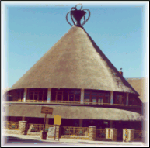
Basotho Hat (Mokorotlo)
©2002: Tourist Office
|
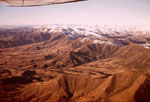
Drakensberg
©2002: Africa Focus
|
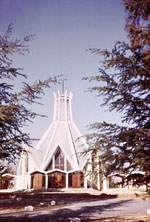
University Catherdral
©2002: Africa Focus
|
|
|
Lesotho is a small, mountainous, landlocked country, entirely surrounded by South Africa. with a surprising combination of rapidly developing modernity, and ancient culture. The Thaba Bosiu plateau is the historical heart of Lesotho. Basotho is known for its Malealea Lodge Pony Project preserves. Maseru, the capital was established in 1869, by Mshweshwe I, the chief of the Basotho nation. He established Maseru near his mountain stronghold of Thaba Bosiu. Today, at Thaba Bosiu lie the remains of his fortifications, his grave and other 19th century buildings. Lesotho is also known as the Mountain Kingdom and has two main mountain ranges: the Drakensberg, which has the highest mountain in southern Africa, and the Maluti. The capital, Maseru, is situated in the lowlands in the west of the country. The climate is temperate with summer rainfall. Snow falls frequently in the highlands during the winter. The people are mostly Basotho, with around 3,000 whites and 2,000 Chinese.
The main religion is Christianity. Churches are a major influence in the life of the Lesotho people. The predominant religion is Roman Catholic. Almost every Lesotho citizen belongs to a church and the church is the location of the social activities for most people. Lesotho has a cold climate with temperatures that go below freezing almost every night in the winter. As fuel for heating and cooking, women and children gather manure from the fields and place it in the sun where it bakes to a very dry consistency. This fuel burns hot, and is clean and affordable. It does not smell or produce much smoke. Missionaries began a university in Lesotho and called it the University of Pius XII. After independence, the church turned the university over to the government. Lesotho then joined with two other small countries, Botswana and Swaziland, to sponsor the university jointly under the name of the National University of Lesotho. The university shop at the entrance sells handicrafts (textiles, pottery, and carvings) made by local people for the tourist market. A few tourists come to Lesotho, mainly from South Africa.
|
Economy:
|
Lesotho has no substantial natural resources other than water. Lesotho sells water to South Africa through the Lesotho Highlands Water Project. The country is also self sufficient for its electricity needs through a hydro electric scheme.
More than 85 percent of the population of 2.1 million lives in rural areas, engaged mainly in agriculture and informal activities. The main crop is white maize which is grown on almost half of the land that is under cultivation. Agriculture contributes about 14 percent of GDP but has remained a supplementary source of income since about half of rural household income comes from family members working in mining and other jobs in South Africa. Historically, the Basuto people of Lesotho were herders rather than cultivators. Although they retain this heritage, more and more of their land is being taken over for crops. As a result, less land is available for grazing, and overgrazing has led to serious problems of erosion.
|
|
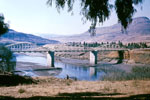
Senqu River (Seaka)
©2002: Africa Focus
|
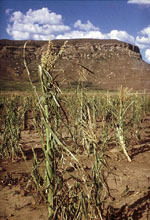
Corn field (Maize)
©2002: Africa Focus
|
|
History:
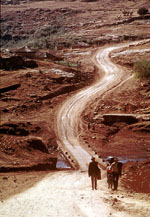
©2002: Africa Focus
|
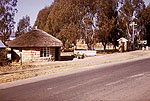
©2002: Africa Focus
|

Cannibals Cave
©2002: Africa Focus
|
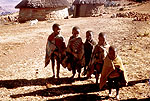
Basuto
©2002: Africa Focus
|
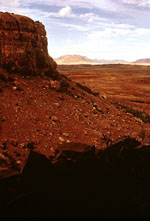
©2002: Africa Focus
|
|
|
The Sotho people have lived in Southern Africa since at least the 10th century AD, moving throughout the region. In the 16th century Sotho people marryied and intermingled with the Khoisan people, and formed small chiefdoms. Extensive trade links were established between the groups, as well as with outside people. Grain and hides, for example, were traded for iron from the Transvaal area. Basotho, the inhabitants of Lesotho, were brought together from scattered ethnic groups in the 19th century by King Moshoeshoe-I and settled together in this mountainous region of southern Africa. King Moshoeshoe-I united the Basuto people during the 1820s and retreated to this area to prevent the annihilation of his people during wars that swept across South Africa. Eventually King Moshoeshoe I signed a treaty with Queen Victoria and his country, called Basutoland, was made a British protectorate.
The Kingdom of Lesotho became a British Protectorate in 1868 upon request from the King. Lesotho regained independence in 1966, and functioned as a multi-party democracy from independence until 1986, when a military regime took power. Lesotho became independent on 4 October 1966 under a Monarch (King Moshoeshoe II) with limited powers and an elected parliament based on voting rights for all. The Prime Minister was Chief Jonathon. In the first post-independence elections in 1970, Prime Minister Jonathon, thinking that the opposition would win, declared a state of emergency and suspended the constitution.
After many years of rule by a Military Council, Lesotho returned to democracy in the General Elections of March 1993, in which the Basotholand Congress Party (BCP) won all 65 seats in Parliament. Lesetho remained a constitutional monarchy. There was considerable unrest in early 1994, and the constitution was suspended and parliament was dissolved. Constitutional rule was restored in September 1994 after mediation by the Presidents of South Africa, Zimbabwe and Botswana. King Moshoeshoe II, who had been dethroned by the Military Council in 1990, returned to the throne from exile in the UK in January 1995. A year later, he was killed in a car accident in the mountains of Lesotho. On the advice of the College of Chiefs, King Letsie III succeeded his father.
Quarrelling within the ruling party resulted in a split in June 1997 and the creation of the Lesotho Congress for Democracy LCD which won the general elections in May 1998, generally declared free and fair. Protests by the opposition parties led to civil disorder. On 16 September 1998, Prime Minister Mosisili wrote to the Presidents of South Africa, Zimbabwe, Botswana and Mozambique asking the Southern African Development Community (SADC) to intervene.
|
A SADC peacekeeping force from South Africa and Botswana entered Lesotho on 22 September 1998. In April 1999, the main SADC peacekeeping force left Lesotho, to be replaced by a SADC team of about 300 military trainers from Botswana, South Africa and Zimbabwe. These are expected to leave Lesotho when the next elections are held.
Enabling us to improve the quality of the content, if you have additonal information, remarks or suggestions, please share it with us by e-mail.
Last update: 24 April 2008
|